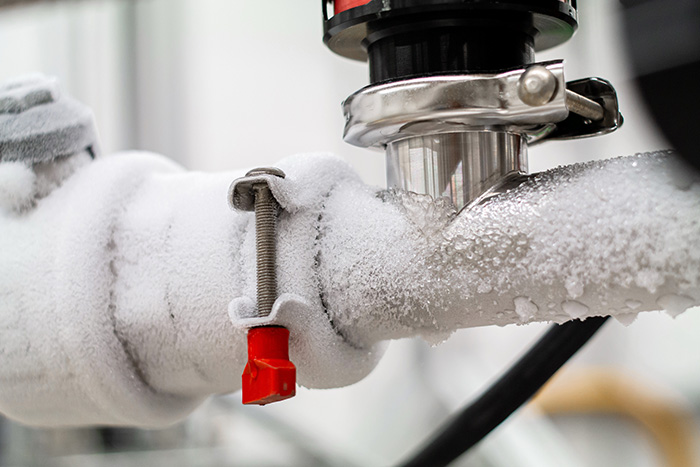Important Advice for Preventing Frozen Pipes in Cold Weather Conditions
Important Advice for Preventing Frozen Pipes in Cold Weather Conditions
Blog Article
Every person seems to have their personal perception about How to Prevent Your Pipes From Freezing.

Cold weather can damage your plumbing, specifically by freezing pipelines. Below's exactly how to prevent it from taking place and what to do if it does.
Intro
As temperature levels decline, the risk of icy pipes increases, potentially leading to expensive fixings and water damages. Understanding just how to stop icy pipelines is crucial for homeowners in cool climates.
Prevention Tips
Protecting prone pipelines
Cover pipes in insulation sleeves or use heat tape to shield them from freezing temperature levels. Focus on pipelines in unheated or outside areas of the home.
Home heating methods
Maintain interior spaces sufficiently heated up, particularly locations with plumbing. Open cupboard doors to enable warm air to circulate around pipelines under sinks.
Exactly how to identify icy pipes
Seek lowered water circulation from taps, unusual odors or sounds from pipes, and noticeable frost on exposed pipelines.
Long-Term Solutions
Architectural adjustments
Think about rerouting pipelines far from outside walls or unheated areas. Add extra insulation to attics, basements, and crawl spaces.
Upgrading insulation
Buy top quality insulation for pipes, attics, and wall surfaces. Appropriate insulation helps keep regular temperature levels and reduces the threat of frozen pipelines.
Securing Outside Pipes
Yard hoses and outside faucets
Detach and drain yard hose pipes before wintertime. Install frost-proof faucets or cover exterior taps with shielded caps.
Recognizing Frozen Pipelines
What creates pipes to freeze?
Pipes ice up when exposed to temperature levels below 32 ° F (0 ° C) for extended periods. As water inside the pipes freezes, it increases, putting pressure on the pipe walls and possibly causing them to break.
Risks and problems
Icy pipes can result in water interruptions, property damages, and pricey repair services. Burst pipes can flooding homes and trigger substantial architectural damages.
Indications of Frozen Piping
Identifying icy pipes early can stop them from bursting.
What to Do If Your Pipelines Freeze
Immediate activities to take
If you suspect icy pipelines, keep faucets available to ease pressure as the ice thaws. Use a hairdryer or towels soaked in hot water to thaw pipes gradually.
Final thought
Preventing frozen pipelines requires proactive steps and fast feedbacks. By recognizing the reasons, signs, and safety nets, property owners can protect their plumbing throughout winter.
Helpful Tips to Prevent Frozen Pipes this Winter
UNDERSTANDING THE BASICS: WHY PIPES FREEZE AND WHY IT’S A PROBLEM
Water freezing inside pipes is common during the winter months, but understanding why pipes freeze, and the potential problems it can cause is crucial in preventing such incidents. This section will delve into the basics of why pipes freeze and the associated problems that may arise.
THE SCIENCE BEHIND FROZEN PIPES
When water reaches freezing temperatures, it undergoes a physical transformation and solidifies into ice. This expansion of water as it freezes is the primary reason pipes can burst. As the water inside the pipe freezes, it expands, creating immense pressure on the walls. If the pressure becomes too great, the pipe can crack or rupture, leading to leaks and water damage.
FACTORS THAT CONTRIBUTE TO PIPE FREEZING
Low Temperatures: Extremely cold weather, especially below freezing, increases the risk of pipes freezing. Uninsulated or Poorly Insulated Pipes: Pipes located in unheated areas, such as basements, crawl spaces, or attics, are more prone to freezing. Insufficient insulation or lack of insulation altogether exacerbates the problem. Exterior Wall Exposure: Pipes running along exterior walls are susceptible to freezing as they encounter colder temperatures outside. Lack of Heating or Temperature Regulation: Inadequate heating or inconsistent temperature control in your home can contribute to frozen pipes. PROBLEMS CAUSED BY FROZEN PIPES
- Pipe Bursting: As mentioned earlier, the expansion of water as it freezes can cause pipes to burst, resulting in significant water damage.
- Water Damage: When pipes burst, it can lead to flooding and water damage to your property, including walls, ceilings, flooring, and personal belongings.
- Structural Damage: Prolonged exposure to water from burst pipes can compromise the structural integrity of your home, leading to costly repairs.
- Mold and Mildew Growth: Excess moisture from water damage can create a favorable environment for mold and mildew growth, posing health risks to occupants.
- Disrupted Water Supply: Frozen pipes can also result in a complete or partial loss of water supply until the issue is resolved.
WHY CERTAIN PIPES ARE MORE PRONE TO FREEZING
- Location: Pipes located in unheated or poorly insulated areas, such as basements, crawl spaces, attics, or exterior walls, are at higher risk of freezing.
- Exterior Pipes: Outdoor pipes, such as those used for irrigation or exposed plumbing, are particularly vulnerable to freezing as they are directly exposed to the elements.
- Supply Lines: Pipes that carry water from the main water supply into your home, including the main water line, are critical to protect as freezing in these lines can affect your entire plumbing system.
- Underground Pipes: Pipes buried underground, such as those connected to sprinkler systems or outdoor faucets, can be susceptible to freezing if not properly insulated.
https://busybusy.com/blog/helpful-tips-to-prevent-frozen-pipes-this-winter/

As a devoted person who reads on Helpful Tips to Prevent Frozen Pipes this Winter, I imagined sharing that excerpt was a good idea. Loved our piece of writing? Please share it. Let somebody else find it. Thanks a lot for taking the time to read it.
Hire A Pro Report this page